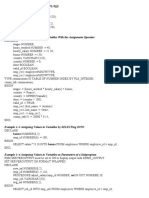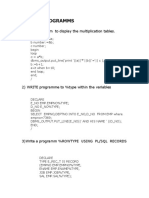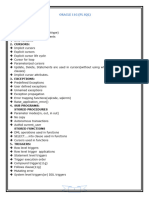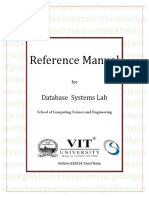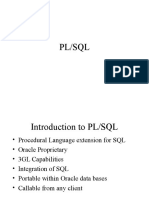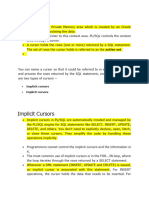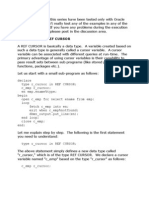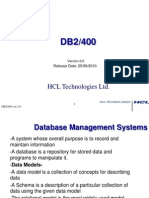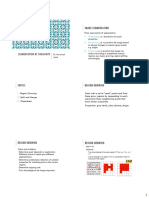0 ratings0% found this document useful (0 votes)
255 viewsUsing RETURNING INTO Clause: RETURNING INTO Clause Allows Us To Return Column Values For Rows Affected by DML Statements
This document discusses using the DBMS_SQL package in Oracle to execute dynamic SQL statements. It describes how to open a cursor, parse a SQL statement, bind variables, define column types, fetch rows, and retrieve column values using DBMS_SQL procedures like BIND_VARIABLE, DEFINE_COLUMN, FETCH_ROWS, and COLUMN_VALUE.
Uploaded by
Anonymous 7r2OlOFVCopyright
© © All Rights Reserved
Available Formats
Download as PPTX, PDF, TXT or read online on Scribd
0 ratings0% found this document useful (0 votes)
255 viewsUsing RETURNING INTO Clause: RETURNING INTO Clause Allows Us To Return Column Values For Rows Affected by DML Statements
This document discusses using the DBMS_SQL package in Oracle to execute dynamic SQL statements. It describes how to open a cursor, parse a SQL statement, bind variables, define column types, fetch rows, and retrieve column values using DBMS_SQL procedures like BIND_VARIABLE, DEFINE_COLUMN, FETCH_ROWS, and COLUMN_VALUE.
Uploaded by
Anonymous 7r2OlOFVCopyright
© © All Rights Reserved
Available Formats
Download as PPTX, PDF, TXT or read online on Scribd
You are on page 1/ 8
Using RETURNING INTO clause
RETURNING INTO clause allows us to return column values for rows
affected by DML statements.
Example:
Declare
Emp_id number := 1001;
Salary_Bonus_percent number := 10;
New_salary number;
Begin
Execute immediate Update emp set salary = salary + (salary*
: Salary_Bonus_percent ) where emp_id = :emp_id returning salary into
:New_salary
using Salary_Bonus_percent , emp_id
Returning into New_salary;
End;
1 10G PL/SQL
Using DBMS_SQL
Prior to Oracle 9i , Dynamic SQL required the use of DBMS_SQL package
which gives greated control over the processing flow with in the
Dynamic SQL, but it is generally more complicated to write than the
native dynamic SQL.
Create or replace procedure anystring(string IN varchar2) is
Begin
Cursor_name integer;
Ret integer;
Cursor_name := DBMS_SQL.open_cursor;
DBMS_SQL.parse(cursor_name , string,DBMS_SQL.Native);
Ret := DBMS_SQL.execute(cursor_name);
DBMS_SQL.close_cursor(cursor_name);
End;
2 10G PL/SQL
Using DBMS_SQL
Execute anystring (drop table CD);
Execute anystring(create table CD (Artist varchar2(25).Title varchar2(25));
Execute anystring(Insert into CD values (MLTR,Sleeping Child));
Using BIND_VARIABLE and BIND_ARRAY procedures:
This procedures are used in passing parameter as Bind variables to dynamic sql
statements.BIND_ARRAY is used to pass more than one parameter.
Usage:-
3 10G PL/SQL
Using DBMS_SQL
Usage:-
DBMS_SQL.Parse(cursor_name,delete from CD where Artist = :artist,DBMS_SQL.Native);
DBMS_SQL.BIND_VARIABLE(cursor_name,:artist,artist_name);
Where artist_name is a parameter which is already declared or passed from calling
environment.
Use BIND_ARRAY To pass more than one parameter.
Usage:-
Declare
cursor_name Integer := dbms_sql.open_cursor;
Ret Integer;
emp_num dbms_sql.number_table;
emp_var dbms_sql.varchar2_table;
4 10G PL/SQL
Using DBMS_SQL
begin
dbms_sql.parse(cursor_name,'insert into emp(emp_id,emp_name) values ( :a, :b
)',dbms_sql.native );
emp_num(1) := 1001;
emp_num(2) := 1002;
emp_var(1) := 'John';
emp_var(2) := 'Naveen';
dbms_sql.bind_array(cursor_name, ':a', emp_num );
dbms_sql.bind_array(cursor_name, ':b', emp_var );
Ret := dbms_sql.execute(cursor_name);
dbms_sql.close_cursor(cursor_name);
end;
5 10G PL/SQL
Using DBMS_SQL
Using DEFINE_COLUMN function:
If your cursor performs a query, you must execute this function once for each column
being selected.Is it basically used to define the datatype and size of the variables that
will receive data from the Fetch_Rows() function
If the column defined with LONG datatype , then DEFINE_COLUMN_LONG must be
used.
Usage:-
.
DBMS_SQL.parse(cursor_name, select artist,title from CD, dbms_sql.native);
DBMS_SQL.DEFINE_COLUMN(cursor_name,1,artist,25);
DBMS_SQL.DEFINE_COLUMN(cursor_name,2,title,25);
.
6 10G PL/SQL
Using DBMS_SQL
Using FETCH_ROWS:
This function fetches a single row of data into the local buffer. This data can
then be stored in local variables by using the Column_Value() procedure.
Ret := DBMS_SQL.FETCH_ROWS(cursor_name);
Using COLUMN_VALUE:
This procedure stores the fetched single row of data into local variables.
DBMS_SQL.COLUMN_VALUE(cursor_name,1,artist);
DBMS_SQL.COLUMN_VALUE(cursor_name,2,title);
7 10G PL/SQL
Using DBMS_SQL
Using VARIABLE_VALUE:
BEGIN
cursor_name := dbms_sql.open_cursor;
dbms_sql.parse(cursor_name, 'INSERT INTO emp VALUES
(:empid,:salary,:bonus_percent) ' ||
'returning salary+(salary*bonus_percent) into :new_salary', dbms_sql.native);
dbms_sql.bind_variable(cursor_name, 'empid', v_empid);
dbms_sql.bind_variable(cursor_name, 'salary', v_salary);
dbms_sql.bind_variable(cursor_name, 'bonus_percent', v_bonus_percent);
dbms_sql.bind_variable(cursor_name, 'new_salary', v_new_salary);
n := dbms_sql.execute(c);
dbms_sql.variable_value(cursor_name, 'new_salary', v_new_salary); -- get value
of outbind
dbms_sql.close_cursor(c);
END;
8 10G PL/SQL
You might also like
- LPS 1048 Requirements For The Approval of Sprinkler System Contractors in The UK and IrelandNo ratings yetLPS 1048 Requirements For The Approval of Sprinkler System Contractors in The UK and Ireland29 pages
- 2006 Stanford Consulting Case Interview Preparation100% (4)2006 Stanford Consulting Case Interview Preparation62 pages
- Examples : Execute Anystring ( Create Table Emp (Name Varchar2, Age Number (3), Salary Number (20) ) ')No ratings yetExamples : Execute Anystring ( Create Table Emp (Name Varchar2, Age Number (3), Salary Number (20) ) ')10 pages
- Example 1-1 Declaring Variables in PL/SQL: Bonus NUMBER (8,2)No ratings yetExample 1-1 Declaring Variables in PL/SQL: Bonus NUMBER (8,2)23 pages
- Example: Datatype Cursor Varchar2 VariableNo ratings yetExample: Datatype Cursor Varchar2 Variable14 pages
- Lecture 3.1.1 - Subprogram - ProceduresNo ratings yetLecture 3.1.1 - Subprogram - Procedures18 pages
- PL/SQL Programms: WRITE A Program To Display The Multiplication TablesNo ratings yetPL/SQL Programms: WRITE A Program To Display The Multiplication Tables33 pages
- Working With Composite Data Types: L/O/G/ONo ratings yetWorking With Composite Data Types: L/O/G/O67 pages
- Dynamic SQL in PL/SQL: Steven FeuersteinNo ratings yetDynamic SQL in PL/SQL: Steven Feuerstein34 pages
- Stored Procedures: What Is A Stored Procedure?No ratings yetStored Procedures: What Is A Stored Procedure?5 pages
- Create or Replace Function Fact (N Number) Return Number Is I NUMBER (10) F Number: 1 Begin For I in 1.. N Loop F: F I End Loop Return F EndNo ratings yetCreate or Replace Function Fact (N Number) Return Number Is I NUMBER (10) F Number: 1 Begin For I in 1.. N Loop F: F I End Loop Return F End5 pages
- Chapter 05 (Built-In SQL Functions) PDFNo ratings yetChapter 05 (Built-In SQL Functions) PDF44 pages
- Write and Execute PL-SQL Functions and Procedure ProgramsNo ratings yetWrite and Execute PL-SQL Functions and Procedure Programs11 pages
- Powerexchange For Sap Netweaver 8.6 Transport Versions Installation NoticeNo ratings yetPowerexchange For Sap Netweaver 8.6 Transport Versions Installation Notice3 pages
- DB2 Transparencies (Unit 3) : DB2 - TR Ver. 1.0.0 04/12/1998 Page 1 of 54No ratings yetDB2 Transparencies (Unit 3) : DB2 - TR Ver. 1.0.0 04/12/1998 Page 1 of 5454 pages
- Statement of Account: Date Narration Chq./Ref - No. Value DT Withdrawal Amt. Deposit Amt. Closing BalanceNo ratings yetStatement of Account: Date Narration Chq./Ref - No. Value DT Withdrawal Amt. Deposit Amt. Closing Balance8 pages
- S250-M3 RockDrill 24x36 WallChart English Dec 2013 WebReady PDF100% (1)S250-M3 RockDrill 24x36 WallChart English Dec 2013 WebReady PDF1 page
- Manahan Residence - Proposal For Aircondititoning WorksNo ratings yetManahan Residence - Proposal For Aircondititoning Works3 pages
- Power Plant Interpreting Diagrams Practice TestNo ratings yetPower Plant Interpreting Diagrams Practice Test8 pages
- Asynchronous Elastic Search Log AppenderNo ratings yetAsynchronous Elastic Search Log Appender7 pages
- PDF Print Complete Mathematics For Cambridge IGCSE® Fifth Edition ExtendedNo ratings yetPDF Print Complete Mathematics For Cambridge IGCSE® Fifth Edition Extended514 pages
- Polaris Sportsman700-800-800 X2 EFI PDFNo ratings yetPolaris Sportsman700-800-800 X2 EFI PDF393 pages
- LPS 1048 Requirements For The Approval of Sprinkler System Contractors in The UK and IrelandLPS 1048 Requirements For The Approval of Sprinkler System Contractors in The UK and Ireland
- 2006 Stanford Consulting Case Interview Preparation2006 Stanford Consulting Case Interview Preparation
- Examples : Execute Anystring ( Create Table Emp (Name Varchar2, Age Number (3), Salary Number (20) ) ')Examples : Execute Anystring ( Create Table Emp (Name Varchar2, Age Number (3), Salary Number (20) ) ')
- Example 1-1 Declaring Variables in PL/SQL: Bonus NUMBER (8,2)Example 1-1 Declaring Variables in PL/SQL: Bonus NUMBER (8,2)
- PL/SQL Programms: WRITE A Program To Display The Multiplication TablesPL/SQL Programms: WRITE A Program To Display The Multiplication Tables
- Create or Replace Function Fact (N Number) Return Number Is I NUMBER (10) F Number: 1 Begin For I in 1.. N Loop F: F I End Loop Return F EndCreate or Replace Function Fact (N Number) Return Number Is I NUMBER (10) F Number: 1 Begin For I in 1.. N Loop F: F I End Loop Return F End
- Write and Execute PL-SQL Functions and Procedure ProgramsWrite and Execute PL-SQL Functions and Procedure Programs
- Powerexchange For Sap Netweaver 8.6 Transport Versions Installation NoticePowerexchange For Sap Netweaver 8.6 Transport Versions Installation Notice
- DB2 Transparencies (Unit 3) : DB2 - TR Ver. 1.0.0 04/12/1998 Page 1 of 54DB2 Transparencies (Unit 3) : DB2 - TR Ver. 1.0.0 04/12/1998 Page 1 of 54
- Statement of Account: Date Narration Chq./Ref - No. Value DT Withdrawal Amt. Deposit Amt. Closing BalanceStatement of Account: Date Narration Chq./Ref - No. Value DT Withdrawal Amt. Deposit Amt. Closing Balance
- S250-M3 RockDrill 24x36 WallChart English Dec 2013 WebReady PDFS250-M3 RockDrill 24x36 WallChart English Dec 2013 WebReady PDF
- Manahan Residence - Proposal For Aircondititoning WorksManahan Residence - Proposal For Aircondititoning Works
- PDF Print Complete Mathematics For Cambridge IGCSE® Fifth Edition ExtendedPDF Print Complete Mathematics For Cambridge IGCSE® Fifth Edition Extended

















